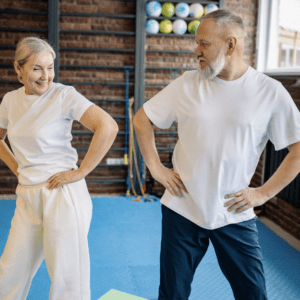Strong And Steady: More Insights On Preventing Falls

Strong And Steady: More Insights On Preventing Falls
November 30, 2022
As we approach the winter weather season, it’s likely that we’ll face more risk of slipping and falling outside. With slick surfaces, clunkier footwear, and just more fear of falling, the chances of a fall and possible injury go up. No doubt there are plenty of resources and recommendations, on agebuzz and elsewhere, about how to keep yourself strong and steady whether out in the cold or inside your home. But new research and insights continue to be published about what puts you at risk, how you can proactively improve your balance, and what signs may signal you’re likely to fall. So let’s take a look at some recent studies and the latest thinking when it comes to preventing falls and injury.
First, a reminder as to why this is a repeated topic of interest. According to the CDC, there are 36 million falls among older US adults each year, leading to one fall every second of every day. More than 32,000 of those falls lead to death, and falls are the leading cause of injury and death from injury among those 65 and older. Moreover, one in four adults over age 65 each year experiences a fall and that risk doubles for those with vision impairment or some other chronic illness such as diabetes or heart disease. So, chances are, you or someone you know may be at risk of falling in the months to come.
Outside of age, how else do you know if someone is at risk? Beyond prior falls and fear of falling, other factors such as medications, weak leg strength, balance or walking problems, foot problems or poorly fitting shoes, and trip hazards can all signal you are at increased risk. Writer and caregiving expert Carol Levine recently described her own fall and research into vision problems that can raise your risk of falling, and new research out of Australia describes how the number of daily steps you take can suggest when you might be at risk (not surprisingly, fewer steps per day signal a greater chance of falling). Another new study publish in JAMA Internal Medicine reports that those who take a daily low-dose aspirin have an almost 10% increased risk of a serious fall requiring hospitalization. This may lead to more cautious prescribing of aspirin and may also reflect the increased risk of bleeding and bruising that aspirin can cause in older adults. To find out more, read here.
So how to protect yourself? We may sound like a broken record, but we’ll repeat the mantra once again: Balance exercises and leg strengthening are critical components of any fall protection program. With better stability, strength, and mobility, you will lessen your likelihood of a serious fall. For some ways to get started, and visual examples to guide you, get some comfortable clothing, good lighting, and a chair to grab and click here. Consumer Reports also just published a balance regimen designed to keep you upright and steady, and also recommended you seek out a balance program often available at senior centers or local Y’s called Moving For Better Balance. If you’re looking for some external support, you may want to take a look at a recent post in Daily Caring, which features an in-depth discussion of how to properly use a cane to help with balance and fall protection, and includes a YouTube video demonstrating proper technique. Finally, there continue to be good options available through medical alert systems. While those systems cannot prevent a fall, they can be invaluable for immediate notification and assistance should you sustain an injury or be unable to get yourself up.







